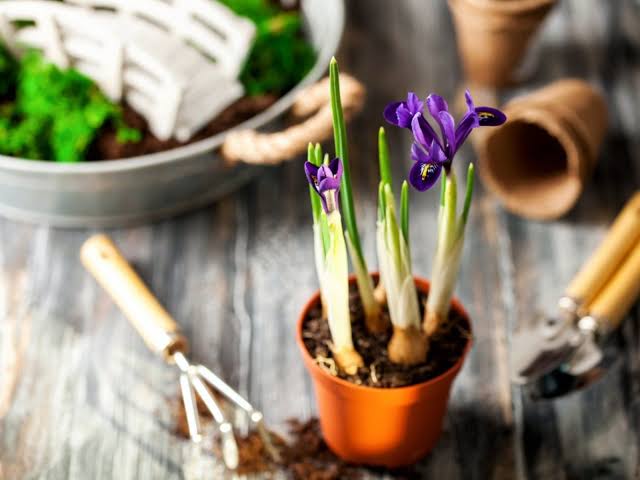If you’re dreaming of a vibrant, colorful garden that bursts into life each spring, planting irises is the perfect place to start. These elegant, hardy blooms come in stunning shades of purple, yellow, blue, and white — and they’re surprisingly easy to grow. In this guide, you’ll learn everything you need to know to Transform Your Garden with How to Plant Iris Bulbs!Whether you’re a beginner gardener or a seasoned pro, this simple step-by-step guide will help you grow healthy, show-stopping irises that return year after year.🌼 Introduction: The Beauty of Irises in the GardenIrises are one of the most striking flowers you can add to your landscape. With their tall, graceful stems and vibrant petals, they bring texture, color, and elegance to any garden design.The best part? Planting iris bulbs (technically rhizomes) is easy and rewarding. They require minimal care once established and can thrive in a variety of climates. Whether you live in the United States, the United Kingdom, or Canada, this guide will help you grow irises successfully — even if you’re new to gardening!So, let’s dig in and Transform Your Garden with How to Plant Iris Bulbs!🌱 Understanding Iris Bulbs (Rhizomes)Before we plant, it’s important to understand that iris “bulbs” are actually rhizomes — thick, fleshy root systems that sit partially above the soil.There are several types of irises, including:Bearded Irises: The most popular variety, known for their fluffy “beards” on the petals.Siberian Irises: Hardy and elegant, perfect for cooler climates.Dutch Irises: Typically grown from true bulbs, great for cut flowers.Japanese Irises: Thrive in moist, slightly acidic soil.Each type has slightly different care requirements, but the planting process is largely the same — and you’ll see how easy it is in this step-by-step guide.🌸 Step-by-Step: How to Plant Iris Bulbs1. Choose the Right LocationIrises love full sun — at least 6 hours of sunlight daily. Choose a spot with good air circulation and well-draining soil.Avoid areas that stay soggy after rain. Too much moisture can cause the rhizomes to rot.💡 Tip: If you have clay soil, mix in sand or compost to improve drainage before planting.2. Prepare the SoilLoosen the soil to about 12 inches deep. Mix in compost or organic matter to enrich it. Irises prefer slightly neutral to alkaline soil (pH 6.8–7.5).A well-prepared bed will give your irises the nutrients they need to thrive.3. Plant the Iris RhizomesNow the fun part!Timing: The best time to plant iris bulbs is late summer to early fall (August–October).Spacing: Space each rhizome 12–18 inches apart to allow for growth.Depth: Dig a shallow hole or trench. Form a small mound of soil in the center.Placement: Place the rhizome on the mound with roots spread out on each side. The top of the rhizome should be partially exposed — don’t bury it completely.Cover lightly: Gently press soil around the roots, leaving the top exposed to sunlight.Water lightly after planting to help the roots settle.4. Watering and MaintenanceOnce planted, irises need light, consistent watering — just enough to keep the soil slightly moist.After they’re established, water only during dry spells.Avoid overwatering, which can lead to root rot.💧 Pro Tip: Irises prefer “tough love” — too much attention or water can do more harm than good!5. Feeding Your IrisesFeed your irises with a low-nitrogen fertilizer (like 5-10-10) in early spring and again after blooming.Avoid using high-nitrogen fertilizers, which can cause excessive leaf growth but fewer flowers.6. Pruning and DividingAfter the blooms fade, remove spent flower stalks but leave the green leaves — they continue to feed the rhizome.Every 3–4 years, dig up and divide your iris rhizomes to prevent overcrowding. This keeps the plants healthy and encourages more blooms.Here’s how:Gently lift the clump with a garden fork.Separate the rhizomes, keeping only the healthiest pieces.Replant immediately in fresh soil.🌷 Practical Tips to Transform Your Garden with IrisesMix colors and varieties: Combine bearded, Dutch, and Siberian irises for layered textures and colors.Use irises in borders: Their tall, upright form makes them perfect for garden borders or pathways.Add companion plants: Pair with peonies, daylilies, or lavender to enhance your garden’s beauty.Watch for pests: Keep an eye out for iris borers — small caterpillars that damage rhizomes. Remove infected plants promptly.Mulch carefully: Use a thin layer of mulch to retain moisture, but don’t cover the rhizomes completely.🌼 Why Irises Are Perfect for Every GardenHere’s why you’ll love transforming your outdoor space with this How to Plant Iris Bulbs guide:🌞 Low maintenance: Once established, irises are drought-tolerant and resilient.🌸 Perennial beauty: They return year after year with minimal effort.🎨 Color variety: Available in nearly every color imaginable — perfect for any garden theme.🌿 Pollinator-friendly: Bees and butterflies love them!Whether you have a small backyard or a sprawling garden, irises add timeless elegance and charm to any landscape.🌺 Common Mistakes to Avoid When Planting Iris BulbsPlanting too deep: The rhizome top should always be slightly exposed.Overcrowding: Irises need space and airflow to prevent disease.Poor drainage: Always plant in well-draining soil — soggy soil leads to rot.Too much nitrogen: Causes lush leaves but fewer blooms.Ignoring division: Divide regularly to keep plants vibrant.Avoiding these simple mistakes ensures your irises will flourish season after season.🌷 When to Expect BloomsMost irises bloom in late spring to early summer, depending on the variety and climate.If you plant multiple iris types, you can enjoy blooms from April through July — creating a long-lasting display of color!🌿 Conclusion: A Garden Transformation in BloomIt doesn’t take a professional gardener to grow stunning irises. With just a little care and the right planting technique, you can Transform Your Garden with How to Plant Iris Bulbs!These graceful flowers reward you with spectacular color, delicate fragrance, and long-lasting beauty. They’re proof that even the simplest gardening projects can bring incredible results.So grab your gardening gloves, a few iris rhizomes, and start planting today — your garden will thank you come spring! 🌸🌿✨

